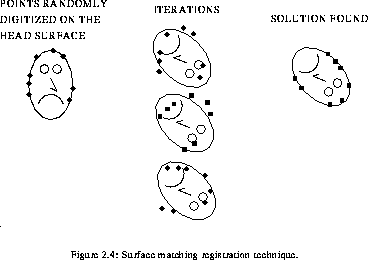
Commonly referred to as the ``head and hat'' algorithm, this method does not require the identification of homologous points (surface_match). Instead, it tries to find the best transformation between the surface defined in scanner space (head) and surgical space (hat) by finding the minimum of an objective function of the transformation parameters [40,44,45,46]. The hat points, whose number is typically much larger than the number of points used in homologous point matching, are gathered randomly and uniformly on the surface of the patient's skin. The head is constituted by the 3-D reconstruction of the patient's surface. A starting point for the iterative process can be obtained by performing a rough homologous point match. The iterative nature of this process has the disadvantage that the search could converge toward a local minimum of the objective function.

ISG uses a variation of this algorithm to perform the surface fit [16]. The principle of their approach is to perform a series of homologous point matching iterations. At each step, every point of the hat (measured on the patient's surface by the probe) is associated with its nearest head point (taken on the reconstructed surface of the patient) to form an homologous pair, and a transformation matrix is computed based on these pairs. The process is stopped when the transformation found at one iteration does not significantly change from that at the previous iteration.